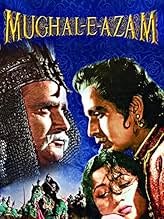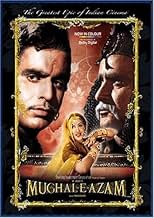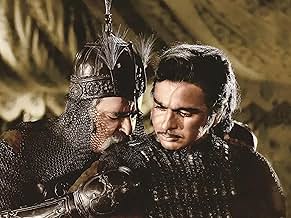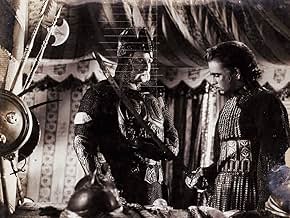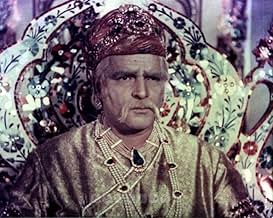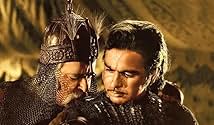AVALIAÇÃO DA IMDb
8,1/10
9,3 mil
SUA AVALIAÇÃO
Adicionar um enredo no seu idiomaA 16th century prince falls in love with a court dancer and battles with his emperor father.A 16th century prince falls in love with a court dancer and battles with his emperor father.A 16th century prince falls in love with a court dancer and battles with his emperor father.
- Prêmios
- 3 vitórias e 3 indicações no total
Prithviraj Kapoor
- Emperor Akbar
- (as Prithviraj)
Ajit Khan
- Durjan Singh
- (as Ajit)
Jillo
- Anarkali's Mother
- (as Jillo Bai)
Sheila Dalaya
- Suraiya
- (as Sheela Delaya)
Tabassum Govil
- A Tawaif
- (as Baby Tabassum)
Avaliações em destaque
I haven't seen the black and white original of Mughal E Azam since the '80's, but I recently saw the restored revived colourised 2004 re-release for the first time and was astounded by the results. I'm not a believer in messing around with the originals, but bearing in mind director Asif always wanted to make the whole film in colour but didn't have enough money the "final" product is amazing to see - such is technology! It was incredibly expensive to make as it was, the restoration process must have cost a fabulous amount too.
Seminal Indian epic purporting to deal with events from about 400 years ago around Prince Saleem (Dilip Kumar) falling in love with a court dancer Anarkali (Madhubala) to his father Akbar's utter opposition and eventually causing a rift leading to all out war. The drama and war spectacle scenes are memorable enough, with thousands of humans and animals as extras, and the music is uniformly superb too. But it's Pyar Kiya To Darna Kya (If I have loved someone>why should I be afraid?) sung by Anarkali (Lata) to the 2 of them in the Hall Of Mirrors that is absolutely stunning - I will have to get the original and compare, because the remaster seems to have turned this song into something even more magical and mesmerising than I remembered. It took Naushad and Shakeel Badayuni one night to compose music and lyrics so timeless - a colourful piece of poetry in motion, with the insistent kaleidoscopic climax added by Asif. Awesome! According to the legend it was supposed to have an unhappy ending - needless to say I'm glad it was altered here to a happy one after such a roller-coaster ride!
A tremendous work of Art, showing the very best of Indian cinema.
Seminal Indian epic purporting to deal with events from about 400 years ago around Prince Saleem (Dilip Kumar) falling in love with a court dancer Anarkali (Madhubala) to his father Akbar's utter opposition and eventually causing a rift leading to all out war. The drama and war spectacle scenes are memorable enough, with thousands of humans and animals as extras, and the music is uniformly superb too. But it's Pyar Kiya To Darna Kya (If I have loved someone>why should I be afraid?) sung by Anarkali (Lata) to the 2 of them in the Hall Of Mirrors that is absolutely stunning - I will have to get the original and compare, because the remaster seems to have turned this song into something even more magical and mesmerising than I remembered. It took Naushad and Shakeel Badayuni one night to compose music and lyrics so timeless - a colourful piece of poetry in motion, with the insistent kaleidoscopic climax added by Asif. Awesome! According to the legend it was supposed to have an unhappy ending - needless to say I'm glad it was altered here to a happy one after such a roller-coaster ride!
A tremendous work of Art, showing the very best of Indian cinema.
This film is by far one of the best, I have seen. One is sure to be mesmerized by the love affair, the Mughal Emperor and the India of that time. The film being in Urdu language also adds originality and aura. The dialogs and direction is superb. The voice of late Prithvi Raj Kapoor as Akbar is beyond compare. Salim, played by Dilip Kumar is one of his best known acting and film. Madhubala seems great, and I definitely feel, she rivals any modern day actress in her beauty, grace and boldness and courage. I watched the latest 2004 re-release of this film in a theater and the experience was superb. I had earlier watched the movie (earlier release) in television before, but the latest release in colour and Dolby digital sound adds to the experience. Talking about a Hindi film, one definitely has to applaud it's songs. Based on Classical music, the songs adds life to the film and are strongly linked with the story-line as well. The best part I felt as a modern gen. guy is the passion and the customs and respect towards his/her duties and elders and system. Akbar's court was also known his secular principles. He had cordial relations with Rajputs(Hindu) too with his wife Jodha Bai herself being from Rajput clan and Man Singh as the head of his infantry. The movie shows the love and emotions through powerful poetic words (dialoges). This is one of the best parts of this film. One can learn many things from this film and is sure to bring in oneself an increased understanding towards one's duties and sacrifice. A must watch for one and for all ... and do watch with keenness and each word spoken in the movie is worth it.
When one thinks of great movies they remember the classics such as gone with the wind, Ben hur etc... but let us not forget one of the greatest cinematic triumphs of Hindi Cinema Mughal-e-Azam a film set in the times of the great Moughul Empire. Having seen both the part B/W and Colour and the remastered full colour version I can truly say that the colourised version truly brings out the true glory of this amazing classic putting it in a league way beyond the Classics of today. The dialogue is simply superb and the acting truly amazing modern filmmakers could learn thing or two about acting. The cinematography is simply stunning for a movie of its time. the grandeur and opulence of the sets really comes out in full colour. The story though not very relevant for modern times shows the views and attitudes of India's past. a truly great film to watch...
Some films are popular only in their own time and some films continue to fascinate successive generations that is the essential difference between a good film and a classic one Mughal-e-Azam
K. Asif was the Indian "Cecille B. Demille" (who was known as CB, in the industry)conceived and executed his vision on a grand Scale. There will only be one "Ben-Hur", one "Lawrence of Arabia", one "Sound of Music", one "Sangam", one "Gadar-Ek Prem Katha" and only one "Mughal-E-Azam". The grand scale is evident in the lyrical poetry set into music by music maestro Naushad, which laid the rich tapestry for this Magnum Opus. Prithviraj Kapoor, was the doyen, who started Prithvi theaters and was the patriarc of the Kapoor Clan, which included The older Raj Kapoor, Shammi Kapoor, and Sashi Kapoor. The most talented was Raj kapoor, who was the "Barnum" of the Indian Cinema. He made countless movies and everyone of them a masterpiece, but the best was "Sangam" (1963). Baritone voiced Prithviraj Kapoor, was in the same genre as Charlston Heston,Laurence Olivier and Richard Burton, an actor's actor; a style that was unique and patented. After I watched the movie after three decades, few things stood out-the ornate settings for the Madhubala's (Born as Mumtaz Begum, was married to singer/actor Kishore Kumar, and died at age of 36, from a congenital heart problem), dance sequence, the rich music, the beauty of the yesteryear actresses and the devotion of the directors to make a statement-not just a movie. For current tastes and standards("Dabaang" "Three Idiots" "Housefull 2" produced by the Bollywood suvvar scum maggots,) the movie is a drag, but for the masses in the bygone years that starved for class and elegance, this was a treat. I was not too impressed with Dilip Kumar, as young Prince, most of the time he looked distant and lost. Suffice to say he matured to be good actor ("Ram aur Shyam") in the later years. The two that carried the mantle were Kapoor and Madhubala.
Você sabia?
- CuriosidadesThe song "Pyar Kiya To Darna Kiya" has an unusual history to it: it cost Rs. 10 million at a time when a film would be made for less than a million; it was written and re-written 105 times by the lyricist, Shakeel Badayuni, before the music director, Naushad, could approve of it; it was shot in the renowned Sheesh Mahal (Palace of Mirrors); and in those days of sound recording, editing and mixing, as there was no way to provide the reverberation of sound, Naushad had playback singer Lata Mangeshkar sing the song in a studio bathroom.
- Erros de gravaçãoMusic and dancing styles from the 19th century were depicted, although the story takes place in the 16th century. For example, Thumri, a semi-classical music form developed in the 19th century, is adopted in a dance sequence in Kathak style, which is a 16th-century dance form.
- Cenas durante ou pós-créditos2004: The End Credits play the song 'Pyaar Kiya To Darna Kya' and its 1960 end credits are adjacent to the 2004 (Technicians) credits.
- Versões alternativasThe original version is in B/W and only one song 'Pyar kiya to darna kya...' was shot in color as most of the film (by the time color technology was available) was complete. This was at the end of almost 10 years that the film was being completed. However, the year 2004 re-release is re-mastered from the original B/W version to Color with Dolby Digital sound and some visual enhancements.
- ConexõesFeatured in Century of Cinema: And the Show Goes On: Indian Chapter (1996)
Principais escolhas
Faça login para avaliar e ver a lista de recomendações personalizadas
- How long is Mughal-E-Azam?Fornecido pela Alexa
Detalhes
- Data de lançamento
- País de origem
- Central de atendimento oficial
- Idiomas
- Também conhecido como
- The Great Mughal
- Empresa de produção
- Consulte mais créditos da empresa na IMDbPro
Bilheteria
- Orçamento
- ₹ 15.000.000 (estimativa)
- Faturamento bruto nos EUA e Canadá
- US$ 161.434
- Fim de semana de estreia nos EUA e Canadá
- US$ 60.258
- 3 de abr. de 2005
- Faturamento bruto mundial
- US$ 161.434
- Tempo de duração3 horas 17 minutos
- Cor
- Mixagem de som
- Proporção
- 1.37 : 1
Contribua para esta página
Sugerir uma alteração ou adicionar conteúdo ausente



